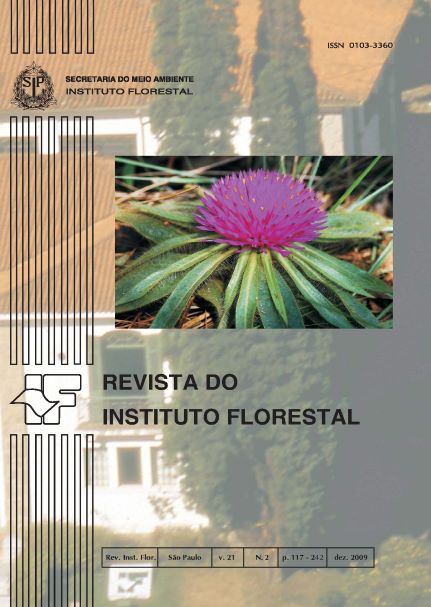COMPORTAMENTO DA VARIAÇÃO GENÉTICA ENTRE E DENTRO DE PROCEDÊNCIAS E PROGÊNIES DE Vell. Moq. PARA CARACTERES QUANTITATIVOS
DOI:
https://doi.org/10.24278/2178-5031.2009212220Keywords:
ex situ conservation, provenance and progenies test, Brazilian tree species, quantitative geneticsAbstract
The aims of this study were to evaluate the behavior of genetic parameters a long of time in a provenance and progeny test of tree species, G. integrifolia established in the Luiz Antônio Experimental Station - EELA, and the effects of different intensity of selection within progenies on the effective population size maintained in the test. The trial was established in 1981 with 17 to 21 progenies of three provenances from São Paulo State (Ribeirão Preto, Campinas and Bauru), using six repetitions, and five plants per subplot. The diameter at breast height - DBH, height, volume and survival were measured at 2, 4, 6, 8 and 23 years of age. Significant differences among provenances, progenies/provenances, interaction provenances and years and interaction progenies/ provenance and years were detected for great majority of the studied traits. The provenance Ribeirão Preto, located nearest to EELA, showed the highest survival rate and significant higher growth rate than the others provenances for majority of the study traits. The genetic variation among provenances was reduced with increase in the age of the trees, while the genetic variation among progenies/provenances increased over the time. The coefficient of genetic variation for volume increased throughout the times and for DBH, height and survival was stable. The coefficient of heritability within progenies for DBH, height and volume was stable over the years. The coefficient of heritability among progenies for height also was stable over the years, but for DBH, volume and survival it showed the tendency to increase with increasing of the years. Finally, the selection of six trees per progeny was determined as the best options to maintain the effective population size in the test and to produce seed with wide genetic base.
Downloads
References
ALLARD, R. W. Princípios do melhoramento genético das plantas. São Paulo: Edgard Blucher, 1971. 381p.
FALCONER,D.S.;MACKAY,T.F.C.Introduction to quantitative genetics. Harlow: Longman Scientific & Technical, 1997. 469p.
FREITAS, M. L. M. et al. Variação genética para caracteres quantitativos em população de Gallesia integrifolia (Spreng.) Harms. Rev. Inst. Flor., São Paulo, v. 20, n.2, p. 165-173, 2008.
FREITAS, M. L. M. et al. Formação de pomar de sementes a partir da seleção dentro de teste progênies de Myracrodruon urundeuva. Rev. Inst. Flor., São Paulo, v. 19, n.2, p. 65-72, 2007.
FREITAS, M. L. M. et al. Parâmetros genéticos em progênies de polinização aberta de Cordia tricothoma (Vell.) ex Steud. Rev. Inst. Flor., São Paulo, v. 18, n. único, p. 95-102, 2006.
KAGEYAMA, P. Y.; DIAS, I. S. Aplicación de conceptos genéticos a espécies forestales nativas en Brasil. Información sobre Recursos Genéticos Forestales, Roma, v. 13, p. 2-10, 1985.
LINDGREN, D.; GEA, L.; JEFFERSON, P. Loss of genetic diversity by status number. Silvae Genetica, Frankfurt, v. 45, p. 52-59, 1996.
LORENZI, H. Árvores brasileiras: manual de identificação e cultivo de plantas arbóreas nativas do Brasil. Nova Odessa: Plantarum, 1992. p. 149, p. 289, p. 340.
NAMKOONG, G. Introduction to quantitative genetics in forestry. Washington, D.C.: Forest Service,1979.342p.(Technical Bulletin,1588).
RITLAND,K.Inferringthe genetic basisofin breeding depression in plants. Genome, Ottawa, v. 39, p.1-8,1996.
S.A.S. INSTITUTE INC. SAS procedures guide. Version 8 (TSMO). Cary, 1999. 454 p.
SEBBENN, A. M. Sistema de reprodução em espécies arbóreas tropicais e suas implicações para a seleção de árvores matrizes para reflorestamentos ambientais. In: HIGA,A. R.; SILVA, L. D. Pomares de sementes de espécies florestais nativas. Curitiba: FUPEF, 2006. p. 93-138.
______. et al. Genetic variation in provenanceprogeny test of Araucaria angustifolia (Bert.) O.Ktze. in São Paulo, Brazil. Silvae Genetica, Frankfurt, v. 52, n. 5-6, p. 181-184, 2003.
______. et al. Genetic variation in Araucaria cunninghamii provenances in Luiz Antônio-SP, Brazil. Crop Breeding and Applied Biotechnology, Viçosa – MG, v.5, p. 1-8, 2005.
______ et al. . Results of an internationalprovenance trial of Cordia alliodora in São Paulo, Brazil at five and 23 years of age. Silvae Genetica, Frankfurt, v. 56, n. 3-4, p. 110-117, 2007a.
______. et al. Conservação ex situ e pomar de sementes em banco de germoplasma de
Balfourodendron riedelianum. Rev. Inst. Flor., São Paulo, v. 19, n.2, p. 101-112, 2007b.
______.; ETTORI, L. C. Conservação genética ex situ de Esenbeckia leiocarpa, Myracrodruon urundeuva e Peltrophorum dubium em teste de progênies misto. Rev. Inst. Flor., São Paulo, v. 13, p.201-211,2001.
______.; KAGEYANA, P. Y.; ZANATTO, A. C. S. Estrutura genética de populações de jequitibá-rosa (Cariniana legalis) por caracteres quantitativos e isoenzimas. Rev. Inst. Flor., São Paulo, v. 13, n.2, p. 121-134, 2001.
SIQUEIRA, A. C. M. F. et al. Comportamento silvicultural e genético de duas espécies arbóreas tropicais secundárias. Rev. Inst. Flor., São Paulo, v.11,n.1,p.53-64,1999.
WRIGHT, J. W. A simplified design for combined provenance and progeny testing. Silvae Genetica, Frankfurt, v. 27, n. 2, p. 68-70, 1978.















